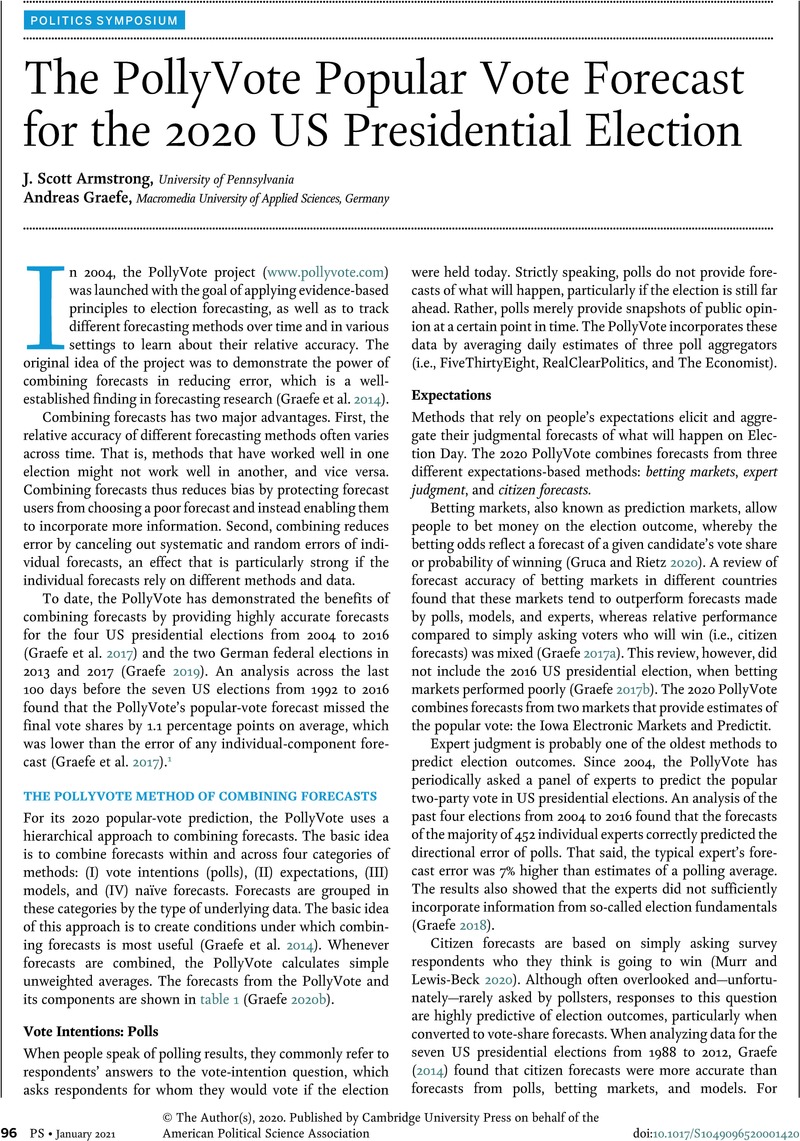No CrossRef data available.
Article contents
The PollyVote Popular Vote Forecast for the 2020 US Presidential Election
Published online by Cambridge University Press: 15 October 2020
Abstract
An abstract is not available for this content so a preview has been provided. Please use the Get access link above for information on how to access this content.

- Type
- Forecasting the 2020 US Elections
- Information
- Copyright
- © The Author(s), 2020. Published by Cambridge University Press on behalf of the American Political Science Association
References
REFERENCES
Armstrong, J. Scott, Green, Kesten C., and Graefe, Andreas. 2015. “Golden Rule of Forecasting: Be Conservative.” Journal of Business Research 68 (8): 1717–31.Google Scholar
DeSart, Jay. 2020. “A Long-Range State-Level Forecast of the 2020 Presidential Election.” PS: Political Science & Politics. doi:10.1017/S1049096520001468.Google Scholar
Erikson, Robert S., and Wlezien, Christopher. 2020. “Forecasting the 2020 Presidential Election: Leading Economic Indicators, Polls, and the Vote.” PS: Political Science & Politics. doi:10.1017/S1049096520001481.Google Scholar
Fair, Ray C. 2009. “Presidential and Congressional Vote‐Share Equations.” American Journal of Political Science 53 (1): 55–72.Google Scholar
Graefe, Andreas. 2014. “Accuracy of Vote Expectation Surveys in Forecasting Elections.” Public Opinion Quarterly 78 (S1): 204–32.Google Scholar
Graefe, Andreas. 2017a. “Political Markets.” In The SAGE Handbook of Electoral Behavior, ed. Arzheimer, Kai, Evans, Jocelyn, and Lewis-Beck, Michael S., 861–82. London: SAGE.Google Scholar
Graefe, Andreas. 2017b. “Prediction Market Performance in the 2016 US Presidential Election.” Foresight: The International Journal of Applied Forecasting 2017 (45): 38–42.Google Scholar
Graefe, Andreas. 2018. “Predicting Elections: Experts, Polls, and Fundamentals.” Judgment and Decision Making 13 (4): 334–44.Google Scholar
Graefe, Andreas. 2019. “Accuracy of German Federal Election Forecasts, 2013 & 2017.” International Journal of Forecasting 35 (3): 868–77.Google Scholar
Graefe, Andreas. 2020a. “Of Issues and Leaders: Forecasting the 2020 US Presidential Election.” PS: Political Science & Politics. doi:10.1017/S1049096520001390.Google Scholar
Graefe, Andreas. 2020b. “Replication Data for: The PollyVote Popular-Vote Forecast for the 2020 US Presidential Election.” Harvard Dataverse. doi:10.7910/DVN/RLECFV.Google Scholar
Graefe, Andreas, and Armstrong, J. Scott. 2012. “Predicting Elections from the Most Important Issue: A Test of the Take-the-Best Heuristic.” Journal of Behavioral Decision Making 25 (1): 41–48.Google Scholar
Graefe, Andreas, Armstrong, J. Scott, Jones, Randall J. Jr., and Cuzán, Alfred G.. 2014. “Combining Forecasts: An Application to Elections.” International Journal of Forecasting 30 (1): 43–54.Google Scholar
Graefe, Andreas, Armstrong, J. Scott, Jones, Randall J. Jr., and Cuzán, Alfred G.. 2017. “Assessing the 2016 US Presidential Election Popular-Vote Forecasts.” In The 2016 Presidential Election: The Causes and Consequences of a Political Earthquake, ed. Cavari, Amnon, Powell, Richard J., and Mayer, Kenneth R., 137–58. Lanham, MD: Lexington Books.Google Scholar
Green, Kesten C., and Armstrong, J. Scott. 2015. “Simple Versus Complex Forecasting: The Evidence.” Journal of Business Research 68 (8): 1678–85.Google Scholar
Gruca, Thomas S., and Rietz, Thomas A.. 2020. “The (Re)Election of 2020 According to the Iowa Electronic Market: Politics, Pandemic, Recession and/or Racial Unrest?” PS: Political Science & Politics. doi:10.1017/S1049096520001419.Google Scholar
Lewis-Beck, Michael S., and Tien, Charles P.. 2020. “The Political Economy Model.” PS: Political Science & Politics . doi:10.1017/S1049096520001365.Google Scholar
Lichtman, Allan. 2020. “He Predicted Trump’s Win in 2016. Now He’s Ready to Call 2020.” New York Times. Accessed August 5, 2020.Google Scholar
Lockerbie, Brad. 2020. “Economic Pessimism and Political Punishment.” PS: Political Science & Politics. doi:10.1017/S1049096520001444
Google Scholar
Murr, Andreas, and Lewis-Beck, Michael S.. 2020. “Citizen Forecasting 2020: A State-by-State Experiment.” PS: Political Science & Politics 53 (4).Google Scholar
Norpoth, Helmut. 2014. “The Electoral Cycle.” PS: Political Science & Politics 47 (2): 332–35.Google Scholar
Philadelphiafed. 2020. “Third Quarter 2020 Survey of Professional Forecasters.” Federal Reserve Bank of Philadelphia. Accessed August 28, 2020.Google Scholar




